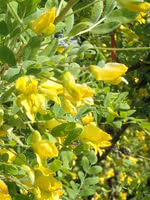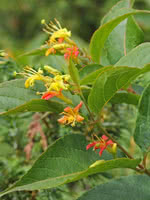Mon-Fri 9am - 5pm Mountain time
Common Caragana vs Northern Bush Honeysuckle
Caragana arborescens
Diervilla lonicera
NOT AVAILABLE THIS SEASON - MIGHT RETURN
Common Caragana is a fast growing shrub that's known for its exceptional hardiness and drought tolerance. Although it's most commonly planted in shelterbelts, Common Caragana is also an excellent hedge or feature shrub.
Note: in warmer areas, this species can be difficult to contain once planted. Use the right plant in the right place.
The Northern Bush Honeysuckle is a small, dense, deciduous shrub. The trumpet-like yellow flowers bloom late spring to early summer. Dark green leaves turn yellow then red in the fall. The flower nectar has a sweet honey taste that can be sucked out of the flower.
Because of its aggressive suckering habit, the Northern Bush Honeysuckle makes a great hedge, shrub border, or thicket in a woodland garden.
Common Caragana Quick Facts
Northern Bush Honeysuckle Quick Facts
In row spacing: 0.3 m (1.0 ft)

